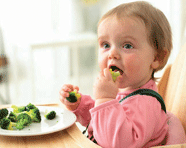Fingers & Spoons

Toward the end of the first year, a baby’s weight gain tends to slow down dramatically. This is a time of growing independence, and often babies who have been good eaters in the past become more difficult to feed.
By around nine months, you’ll notice that your baby may prefer to feed himself. He’ll probably let you know that he’s ready by grabbing the spoon you’re feeding him with or snatching food off your plate. By doing this, your baby learns about food’s texture, smell, and flavour, so it’s important to give him an assortment of foods to try.
Textures
You begin to think everything is going swimmingly with your baby slurping his way through your puréed carrots and sweet potatoes; then you ditch the blender and it all goes downhill. The transition from perfectly puréed to lumpy food can be difficult since many babies are lazy about chewing, but it’s important to give your baby grated, mashed, and chopped food. The muscles a baby uses to chew are the same ones used for speech, so encouraging your baby to chew will help his speech development too. I would recommend stirring tiny soft lumps, like pasta stars or mini pasta shells, into your baby’s favourite purées, gradually increasing the texture and lumpiness of his food. Couscous is another good food; it’s a form of grain made from wheat and you can find it in most supermarkets next to the rice. It’s quick to prepare and nice and soft, so it acts as a gradual transition from purées to a more lumpy texture, and it is tasty with diced vegetables or chicken.
Finger Foods
This can be a stressful time for parents, since babies find it hard to cope with more lumpy food and generally prefer to feed themselves than be fed. Interestingly, while many babies refuse anything with lumps in it, they will often happily chew on finger foods such as cucumber sticks or pieces of fruit. Around eight or nine months, as your child’s hand to eye coordination matures, finger foods will become an increasingly important part of his diet. Your baby’s aim will be far from perfect, but the more you allow him to experiment, the quicker he will learn to feed himself.
Savory Finger Foods
To begin with, it’s best to give steamed vegetables rather than raw. Your baby may be able to bite off a piece of raw carrot and then be unable to chew, so there is a risk of choking. Try steamed carrot sticks or broccoli florets. Later on your baby will become more proficient at chewing, and you can give him raw vegetables. Many babies prefer to be given a whole carrot or chunk of cucumber to chew on, rather than chopping them into small pieces. Other ideas include rice cakes, bread sticks, and pieces of avocado.
Fruity Finger Foods
Fresh fruit makes perfect finger food, but do be careful not to give fruits with pits or whole grapes, since these may cause your baby to choke. Try cutting up a selection of fruits, lay them out on a tray, and let your child pick them up and dunk them into a tasty dip. Begin with soft fruits like bananas, pears, or peaches. Cantaloupe wedges, peeled pear or apple slices, or grapes cut in half are also good. Try dried apricots too—they are a great source of fiber, iron, and vitamins.
Something Cool For Sore Gums
During the three months up to your baby’s first birthday, he may cut several teeth, and sore gums may make eating unpleasant. It’s a good idea to pop something cool like cucumber sticks in the fridge since chewing on something cold can be very soothing. Or freeze a banana for 20 minutes, peel it, and let your baby suck on it.
Tips:
Your baby’s hands should always be washed before and after eating.
Put a little petroleum jelly around your baby’s mouth and chin if he dribbles while teething to prevent any soreness.
As your baby starts to crawl, he will need more energy-rich foods, such as meat, chicken, cheese, pasta, and dried fruit.
You could also try making your own healthy fresh fruit popsicles. You can purée fruits like peaches or mangoes and mix them with orange or tropical fruit juice, or purée, and sieve berry fruits, such as strawberries or raspberries, and mix them with strawberry yogurt. Alternatively, simply pour fresh fruit juice or a smoothie into a popsicle mold and freeze. Other good foods for babies during teething include yogurt, fruit purées, jelly, and risotto.
Mini Meals
Babies have small stomachs and cannot take in too much at each mealtime, so they need light meals that are full of protein and slowreleasing carbohydrates.
Encouraging Healthy Eating
At this age, children are fascinated by what older children and adults are doing, so it is important that your baby is surrounded by people eating normal, healthy meals. Try to sit alongside your baby and eat your own lunch while you feed him. Invite another mom and baby around occasionally—especially if the baby is a good eater.
Dealing With Mess
Mealtimes are going to get messy, so it’s a good idea to put a large plastic or mess mat under the highchair to catch the food that falls on the floor.
Other useful pieces of equipment include a spoon and fork set that is attached to the highchair tray or to the table with a curly wire— so that even if your baby flings the cutlery down, it doesn’t drop on the floor. A bowl with a strong suction base is also a great purchase. There is no need to be obsessive about germs. It’s fine to use an antibacterial wipe to clean your baby’s highchair but, remember, your baby picks things up from the floor and puts them in his mouth all the time. One very common thing that pediatric dietitians talk about is children who are afraid of mess. This seems to be at the root of many toddler eating problems. Allow your baby to experiment—he’s bound to get himself into a mess, but it’s not a good idea to continually wipe your child’s face clean when he is eating.
Choking
Usually, babies gag, cough, or spit food out if they cannot swallow it. However, you should always stay with your baby when he’s feeding himself in case he chokes. Just because your child can chew off a piece of food, like a piece of toast, it doesn’t mean that he can chew it properly. Sometimes babies chew off pieces of food and then store them in their mouths, so always check when you lift your child out of the highchair that there is no lumpy food left in his mouth.When my children were babies, I sometimes found that they would keep food in their mouths long after I thought they had finished. Check that your baby has swallowed everything before you leave the room—especially if you are just starting him on hard finger foods.
- If your child chokes, don‘t try to retrieve the food with your fingers, since this can push it further down the windpipe.
- Lay your baby face down on your forearm, with his head lower than his body. Give him five sharp pats across the top of his back between his shoulder blades. Pick out any visible obstructions with your forefinger and thumb.
- If the obstruction is still present, turn your baby over on to his back and give five sharp thrusts, pushing down with two fingers in the middle of his chest, at a rate of one every three seconds. Then check your baby’s mouth again for any obstruction.
- If unsuccessful, repeat the sequence and call emergency services immediately.
Finger Food Ideas
- vegetables, such as broccoli, carrots, cauliflower, parsnip, and asparagus. Lightly steam or boil them at first so they are a little crunchy, but not hard. Once your baby is more proficient at chewing, you can give him raw vegetables. Other tasty ideas include halved cherry tomatoes and slices of avocado.
- fruit such as banana chunks, apple, peach, melon, or pear slices. Soft fruits are best at first if your baby finds it difficult to chew. Serve with a tasty dip.
- dried fruit like apricots, figs, prunes, or large pieces of apple. Be careful with smaller pieces, such as raisins, since they could cause your baby to choke.
- mini sandwiches with soft fillings.
- starchy finger foods such as strips of toast or pita bread, mini rice cakes, rusks, or bread sticks.
- dry cereals are very handy when you’re on the go. Avoid the sugar-coated varieties, though.
- cold, cooked pasta shapes are great energy-boosters.
- cheese cut into sticks, or cheese slices or mini cheeses.
- protein-rich finger foods such as chicken balls, salmon fishcakes, or small pieces of cooked chicken or turkey.
- popsicles and smoothie sticks, and jello and yogurt can soothe teething gums.
My First Muesli
Baby oatmeal is nice and fine so make a good base on which to add extra—and new—textures.
- Preparation: 4–5 minutes
- Cooking: none
- Makes 1 portion
- Provides potassium, calcium, vits a, B1, B3,& D, prebiotics
2 tbsp baby oatmeal 2 tbsp milk (or breast milk or formula) 1 tbsp strawberry or vanilla yogurt 1/2 small banana, mashed or diced
Mix the oatmeal, milk, and yogurt together, then stir in the banana. Add a little extra milk if your baby likes a runnier consistency.
French Toast Fingers
Cinnamon raisin bread makes a nice alternative to ordinary white bread for French toast—it reminds me of bread pudding. If you don’t have any handy then you can simply add a large pinch of cinnamon to the egg mixture and serve the French toast with a few raisins. Flattening the bread makes it easier for small mouths to chew.
- Preparation: 5 minutes
- Cooking: 4–5 minutes
- Makes 1 portion
- Provides iron, selenium, vits D & E
1 small slice cinnamon raisin bread 1 egg yolk 1 tsp heavy cream (or milk) 1–2 drops of pure vanilla extract Pinch of sugar 1 tbsp butter
Flatten the bread by rolling it out with a rolling pin until it is about half of its original thickness. Beat the egg yolk, cream, vanilla, and sugar together in a small, flat dish.
Melt the butter in a frying pan over medium heat. When the butter is foaming, dip the bread into the egg mixture, then fry in the hot butter for about 2 minutes on each side until golden. Let cool until warm, then serve cut into fingers.
Note: To make two portions, use a whole egg and double everything else.
You can also make French toast using white bread or challah (Jewish egg bread). Slices of grilled cheese on toast make a delicious breakfast for older babies too.



